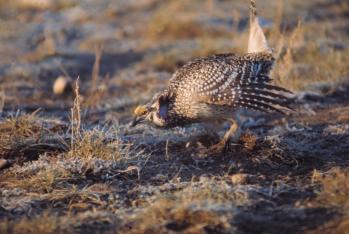
These chicken-like, ground-nesting birds with precocial young can be found in all regions of Saskatchewan. Grouse are members of the subfamily Tetraoninae, family Phasianidae, order Galliformes. There are seventeen species of grouse, distributed across North America, Europe, and northern Asia. Six species of grouse are currently found in this province: greater sage grouse, sharp-tailed grouse, ruffed grouse, spruce grouse, rock ptarmigan, and willow ptarmigan. Greater sage grouse (Centrocercus urophasianus), the largest grouse species in North America (total length: males: 65–75 cm, females: 50–60 cm), are found in silver sagebrush (Artmesia cana) communities of southwestern Saskatchewan. Males perform elaborate courtship displays on dancing grounds or leks. Populations have declined by 80% since 1987. Currently there are about 500 individuals in Canada, and the species is considered endangered. Sharp-tailed grouse (Tympanuchus phasianellus) (41–47 cm total length), the provincial bird, is most common in the grassland and parkland, but is also found in openings in the boreal forest. Males of this species perform courtship displays on leks. Provincial populations are thought to have declined as a result of cultivation of native grasslands. Ruffed grouse (Bonasa umbellus) (total length: males 43–50 cm, females: 40–43 cm) are found in poplar ( Populus spp.) forests, and it has been introduced into the Cypress Hills in southwestern Saskatchewan. Males beat their wings in a drumming display which is often performed from a stump or log. Ruffed grouse populations are cyclic, with peaks in abundance occurring every eight to eleven years. Spruce grouse (Falcipennis canadensis) (total length: 38–43 cm) are found in coniferous forests, typically jack pine or white spruce. Males perform aerial displays, usually in open areas of the forest between tree branches and the ground. Harvest estimates suggest that population cycles are correlated with those of ruffed grouse. Plumage is sexually dimorphic; males have blackish plumage, whereas females have brownish plumage. Willow ptarmigan (Lagopus lagopus) (total length: 35–45 cm) spend the breeding season in birch (Betula) or willow (Salix) shrub habitat. They migrate into the boreal forest of this province from the Northwest Territories during the winter. The rock ptarmigan (L. mutus) is a rare winter visitant to the area near Lake Athabasca. Among the grouse species, only ptarmigan have a white plumage in the winter and have feathered feet. The red grouse and willow grouse found in Europe are of the same species as willow ptarmigan. Population cycles which peak approximately every ten years have also been recorded for this species.
Prior to 1880, the range of greater prairie chickens (Tympanuchus cupido) was contained only within the continental United States. However, in the late 1800s its range expanded into this province; by the turn of the century numbers started to decrease, and by the1970s this species was considered extirpated from Saskatchewan. Range expansion probably occurred from the increased availability of cultivated grain, which enhanced the winter survival of greater prairie chickens. Range contraction probably occurred as native prairie, the habitat used for nesting and brooding, decreased in the landscape. Several other species of gallinaceous birds have been introduced into the province for hunting. These are the ring-necked pheasant (Phasianus colchius) and gray partridge (Perdix perdix) from Europe, and the wild turkey (Meleagris gallipavo) from the east. Only the gray partridge, which is found throughout the southern half of the province, has large populations.
Don McKinnon